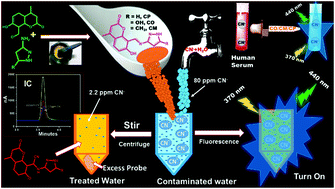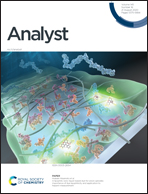Concurrent detection and treatment of cyanide-contaminated water using mechanosynthesized receptors†
Abstract
The development of receptors that can detect as well as treat cyanide ions in aqueous samples is indispensable for environmental protection. Herein, we present the bulk solvent-free and instant green synthesis of a series of turn-on fluorimetric probes that can specifically detect the deadly poison cyanide among various anions and metal ions in water. Selective recognition of cyanide by the mechanosynthesized compounds is even observable by the naked eyes, which remained unaffected in the presence of various challenging species. NMR spectroscopic investigation supports the chemodosimetric sensing of cyanide by the receptors. A remarkable 55–83 fold fluorescence enhancement by the probes enabled us to reach a limit of detection (LOD) in the range of 8–26 ppb, well below the permissible limit of cyanide in drinking water. Being minuscule soluble in water, cyanide treatment studies with the ionophores showed greater than 99% reduction in the free cyanide concentration after three consecutive cycles of operation. Furthermore, the compounds can be used as sensitive probes for the estimation of cyanide in human blood serum in physiological conditions. Overall, the results presented in this article will certainly find great use in the area of cyanide pollution with regard to simultaneous sensing and treatment of free cyanide, which is heretofore unprecedented.



 Please wait while we load your content...
Please wait while we load your content...